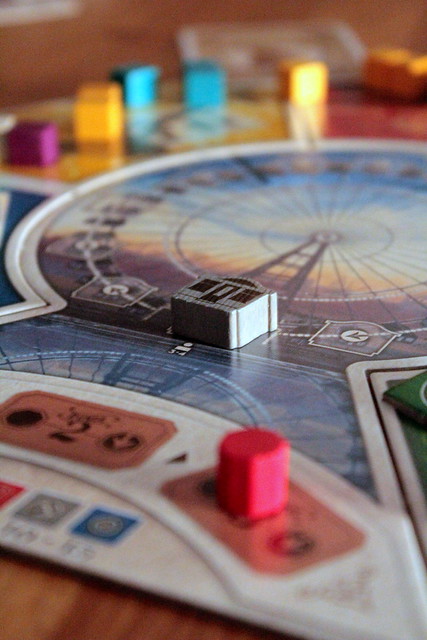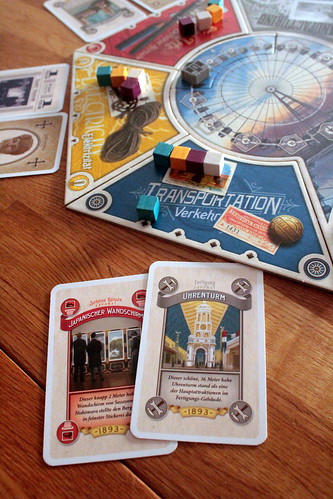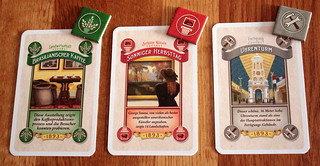| Strategy | Luck |
|---|---|
| Interaction | Components & Design |
| Complexity | Score |
The World’s Columbian Exposition in Chicago has mostly fallen from general awareness. In its day, however, there was a consensus that this event had a transformational power in America exceeding anything since the American Civil War.
Just looking at the inventions which premiered here… The Zipper. Shredded Wheat. Juicy Fruit gum. Diet Soda. The Ferris Wheel. A moving sidewalk. But the event also had many other lasting effects, in society and architecture. And – just a few blocks away – mere years after jack the Ripper gained notoriety, the first American serial killer H. H. Holmes and his house of horrors were in full, shocking operation.
Sorry for getting a bit carried away there. If the story of the fair and the events in Holmes’ castle interest you, we VERY highly recommend the (audio)book by Erik Larson, The Devil in the White City.
But back to the lighter topics, and the Ferris Wheel. Designed to out-Eiffel the Eiffel Tower, and in spite of being completed significantly after the fair had opened, it became one of the symbols of the fair. And so, it is also at the heart of the World’s Fair 1893 game board.
Running the Fair – The Rules

In the game, players take over the posts of directors of the fair, seeking to place the best exhibits into the fair’s programme. To do so, they will need to get exhibits, but also secure the support in the various committees to get these exhibits on display, and to get money/points for visiting the Midway and riding the Ferris Wheel.
The logic of the game is pretty straightforward: Players seek to (a) get exhibits in the five different colors (i.e. sections), to b) get these approved by having influence in the different committees at the end of each round and to (c) form sets of them yielding points. The Ferris Wheel tickets advance the game flow and determine round and game end, but also yield (in comparison: moderate) scoring.
The game is set up around the Ferris Wheel, with the five sections of the exhibition – Agriculture, Electricity, Fine Arts, Manufacturing, and Transportation randomly placed around them. These five areas (and their colour coding) will also be represented in the potential exhibits as well as matching approval tokens explained later on.
The card stack consists of exhibits, influencer cards (representing powerful people associated with the fair who allow you to place additional supporters into the committees) and midway tickets advancing the Ferris Wheel. At the outside of each of the five thematic sections of the game board, two cards are placed.
On a player’s turn, that player chooses one of the sections. They place one of their supporters into this section (thus increasing the presence in that section’s committee; each player starts with one per section), and take all cards beneath it. If the player got an influencer card the previous round, they now must use this card – or discard it unused. If one or more cards taken were Midway tickets, the Ferris Wheel is advanced that many spaces. Exhibit cards are set aside, as are influencer cards (until the next round).

Afterwards, three new cards are added to the board, starting with the now empty section and continuing clockwise, skipping areas which have reached their capacity (which is three or four cards). Thus, at the end of the replenishing phase, there is at least one card beneath each sector.
It is now the next player’s turn to continue in equal fashion, until the Ferris Wheel has made a full rotation (taking 9/11/13 tickets with 2/3/4 players), triggering a scoring and ending the round. The whole game consists of only three rounds, so time is of the essence, as is sequence.
At the end of each round, the majorities in the committees are evaluated based on the number of supporters the players have there. Being well-represented means you will get points, but more importantly have the authority to get exhibits of that colour approved. That means you discard exhibit cards, and get to take a matching-coloured approval token. The number of points and exhibits you can get approved depends on the number of players and how high you rank, but you always need to be among the top two to get anything approved, and the best you can do is four points and three approved exhibits. This process is done separately and individually by colour – after which all players take back half their supporters from that section.
In order to get an exhibit approved, however, you need to have it first. That means, a majority in a colour/section you have no/fewer exhibits for will be gradually less efficient, because you cannot delay the effect. On the other hand, you can hold on to exhibits for the next round, hoping to fare better in the committee and convert exhibits into tokens. This is key as at game’s end: You use the tokens to score, but unapproved exhibits will be quite literally pointless.
As diversity is key, in the final scoring, each completed set of five different-coloured tokens yields 15-points, a set of 4 is ten, etc., where a single token counts just one point. As for the Ferris Wheel, each ticket you contribute to a round scores a point, and the player with most for the round gets a bonus of two points. Add the points you got in the committees, and you have your final score.

So much for the basic rules. So what is the fuss about?
The core strategic elements in the game are which sections to place your supporters in and which cards to take while doing so. Sometimes your move will focus on placing a supporter into a certain committee, while other times the available cards will determine your choice. And many times, this will be a conflict of interest, with tricky priorities. Get the cards from the transportation area which are superb, but risk to lose out on the majority in the agriculture if the round ends before my next turn – since the Ferris Wheel only needs three more steps and there are already two Midway Tickets beneath two of the sections? Or push the Ferris Wheel myself to secure my majority in Agriculture, but may only convert one of my exhibits? Trust us, a lot of times all the options will seem subpar, and especially with more players things become pretty hard to predict. (That being said, the game fortunately doesn’t tend to drift into full randomness.)
This is only magnified by the influencer cards. These allow you to place additional supporters according to certain rules – in the same or to an adjacent sector, in the sector shown on the influencer card – or move supporters between sectors (which may be your own, but can also be others’). These cards are pretty powerful when it comes to getting more supporters and thus the chance for more influence – but unlike exhibits and midway tickets they don’t give you a direct path to scoring. As always… priorities!
The Verdict
World’s Fair 1893 encapsulates the inventions and technological verve of the area, and adding an easy-to-understand and quick-to-learn mechanism to it. The rules are simple enough, but their application and the decisions the players have to take are always new and mostly very tricky. Since cards and information are public, players can scheme their moves according to the other players’ likely moves and decisions.

With about 45 minutes of game time, the game does not drag and the downtime of the players is low, especially with every move changing the landscape of available cards, majorities and thus tactical options.
The materials are nice and easy to read, the colour coding makes recognition quick and easy – and there is plenty of flavour to entertain the so-inclined. If we have one minor beef with the game then it was the fact that each type of influencer card depicts the same person, so you can have two Daniel Burnhams or Bertha Palmers in your hand – which, given the plethora of people relevant to the fair, is an unnecessary element of austerity.
While we would totally go for an H. H. Holmes extension (e.g. randomly removing supporters from the game), World’s Fair 1893 is itself a world’s-fair-worthy piece of gaming, with a great deal of fun, thought and replay value.











